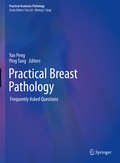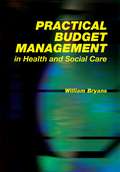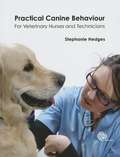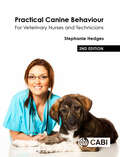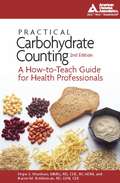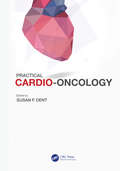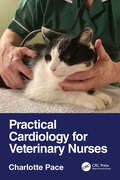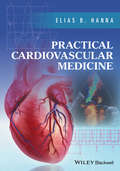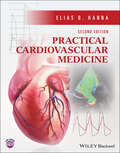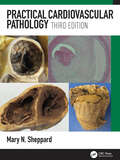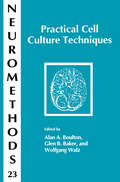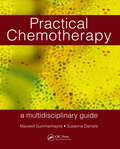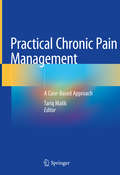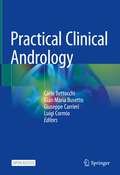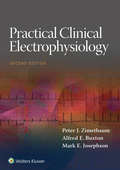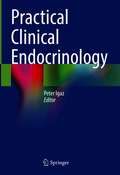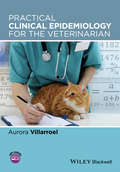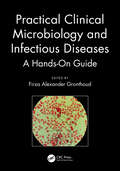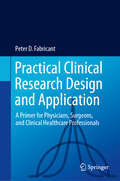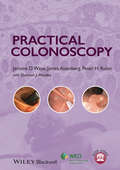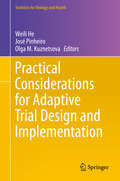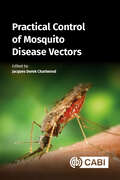- Table View
- List View
Practical Breast Pathology: Frequently Asked Questions (Practical Anatomic Pathology)
by Yan Peng Ping TangThis comprehensive volume reviews current topics and controversies in diagnostic breast pathology, and addresses frequently encountered diagnostic problems using a question and answer format and case presentations. Emphasis is placed on the diagnostic approach as it relates to morphology, clinical and radiographic correlation, differential diagnosis, and ancillary testing including immunohistochemical and molecular analyses. Answers are provided and serve as a practical, evidence-based, and problem solving guide to diagnostic issues having significant impacts on clinical management. Common but diagnostically challenging entities such as papillary lesions and fibroepithelial lesions are discussed in detail, as well as special types of breast cancer including solid papillary carcinoma, lobular lesions and its variants. Uncommon breast lesions such as mesenchymal, lymphoid, and metastatic lesions are also covered. Chapters discuss genetic alterations and molecular abnormalities in breast cancer, and commonly encountered interpretation dilemmas on immunohistochemistry in breast cancer and metastatic cancer to the breast with a focus on prognostic and predictive tumor biomarkers.
Practical Budget Management in Health and Social Care (Radcliffe Ser.)
by Steve Field William BryansPractical budget management is at the core of this book. As well as giving an insight into the way budgets behave in certain circumstances and what can be done about it, the book also deals with practical steps the budget and resource manager can take to eliminate waste and reduce opportunities for fraud and collusion. Better budget management means that the organisation can concentrate greater resources on matters that will significantly enhance patient and client care. The book identifies the day-to-day issues that affect managers in health and social services, and provides advice and a structured approach that facilitate both comprehension of the problem areas and possible solutions. It successfully reduces complex budget issues into manageable chunks, with case studies, key points, tips, and worked examples to aid understanding. It offers practical assistance to managers, tutors, students, board members and other health and social care professionals. The book is third in a trilogy which provides practical solutions to the complex problems of resource, financial and budget management in health and social care. "Managing in Health and Social Care" provides essential checklists for frontline staff is about process quality in financial and business management. It concentrates on doing the right thing, first time, every time. "Resource Management in Health and Social Care": essential checklists is about matching available resources to the environment. It deals with workplace and environmental problems associated with resource scarcity. 'Although there may be constant change to organisation and structures, great improvements in care, treatment, and technology and ever more sophisticated ways of funding health and social care, the actual act of spending money will always be the responsibility of budget managers who are in the front line. This book identifies the day-to-day issues that affect managers in health and social services and provides advice and a structured approach that facilitate both comprehension of the problem areas and possible solutions.' - William Bryans, in the Introduction.
Practical Canine Behaviour
by Stephanie HedgesThere have been ground-breaking advances in our understanding of canine behaviour in recent years. Traditional theories, based on the premise that a desire to be 'pack leader' drives all dog behaviour, have made way for a new and fascinating insight into the subtleties and complexities of canine communication, social behaviour and emotional drives. Keeping abreast of such developments is becoming increasingly essential for veterinary nurses and technicians, both to fulfil client expectations and to protect canine welfare. Yet current training worldwide typically offers little teaching in this area. In this book Stephanie Hedges draws on more than 20 years as a practicing veterinary nurse and her specialist knowledge as a Certified Clinical Animal Behaviourist (CCAB) to provide a quick reference and practically relevant canine behaviour resource to meet the specific needs of the general practice nurse or technician. Contents include: *An introduction to the drives for, management and modification of canine behaviour *New approaches to handling and interaction to improve safety, efficiency and patient welfare *Essential advice for puppy owners and key aspects of running safe in house puppy socialisation classes *Guidance on how to manage the behavioural impact of illness and life changes, and address fear of fireworks and visiting the practice *Client factsheets and behaviour assessment questionnaire *Flow charts for when and where to refer dogs showing problem behaviour
Practical Canine Behaviour: For Veterinary Nurses and Technicians
by Stephanie HedgesIn this book Stephanie Hedges draws on more than 20 years as a practicing veterinary nurse and her training as a Certificated Clinical Animal Behaviourist (CCAB). She provides a quick reference and practically relevant canine behaviour resource to meet both the specific needs of the veterinary nurse or technician and the needs of the wider general practice team. The new edition has been completely revised and updated to include: - New sections on canine emotions, the role of play, and how the canine senses affect a dog's perception of their world and their communication with others - A discussion of the relevance and limitations of breed in our understanding of dog behaviour - Updated and expanded behavioural first aid advice including factors to consider when assessing risk - A new chapter on the practice role in addressing fear of visiting the practice and veterinary interventions - A focus on the emotional welfare of dogs throughout Further topics include application of the 'trigger stacking' principle to reduce stress and aggression in practice, approaches to minimising restraint when handling, advice for puppy owners to prevent future problems, tips for running successful puppy socialization classes, and strategies for managing or addressing unwanted behaviour. Practical Canine Behaviour continues to provide an essential practical resource for the general veterinary practice team, dog trainers, groomers, dog walkers, rescue centre staff, kennel owners and all those who love and care for dogs.
Practical Carbohydrate Counting
by Hope S. Warshaw Karen M. BoldermanThe essentials of teaching carbohydrate counting are presented in this revised and much expanded edition. This resource provides clear and practical approaches that will allow you to help your patients achieve glycemic control with Basic or Advanced Carbohydrate Counting. Includes: reasons for teaching carbohydrate counting, which type, and to whom; complete information on both Basic and Advanced Carbohydrate Counting; skills and readiness checklists for patients; case studies; and much more!
Practical Cardio-Oncology
by Susan F. DentThis book takes a holistic view of the treatment of cardio-oncology patients, from evaluating those at high risk of developing cardio-toxicity, guidance for monitoring and managing patients during therapy to cardiac care of cancer survivors. Throughout, this book utilizes the latest research and guidance to offer advice on treatment strategy as well as practical elements of such as training, cardio-oncology nursing, patient education and how to establish a cardio-oncology unit. This book focuses on the practical knowledge and skills key to successful collaboration between cardiologists and oncologists to achieve the optimum cardiac care for cancer patients. Key Features Focuses on the practical elements of cardio-oncology care Outlines the importance and process of setting up a cardio-oncology unit and cardio-oncology fellowships Provides advice and guidance on the set up and common pit falls of coordinating care for cardio-oncology patients Outlines current guidelines and potential future directions for the field of cardio-oncology
Practical Cardiology for Veterinary Nurses
by Charlotte PaceThis concise textbook provides a comprehensive, practical guide for veterinary nurses and technicians who wish to develop their knowledge, confidence and skills when nursing the cardiac patient. Presentation of dogs or cats with heart disease is common, and it is vital that nurses understand how to look after these patients appropriately and support owners through what can often be challenging times. The book: Begins with basic anatomy and physiology, foundations required to understand the disease processes explained in later chapters Covers diseases seen in small animal practice, including congenital disease, heart failure and treatment options Gives the nurse a sound understanding of electrocardiography, thoracic radiography and cardiac ultrasound: how to perform these, and what they are seeing Covers the hands-on requirements of the veterinary nurse, such as heart auscultation and feeling patient pulses Lists cardiac drugs, explaining when and why pharmacology would be used, as well as side effects Has a dedicated chapter on first aid Discusses chronic nursing management of heart conditions, including remote monitoring, support and care planning. The book is packed with learning features including a Glossary, diagrams, illustrations and tables in full colour, concise end of chapter Key Points and Further Reading lists. Essential reading for student nurses and technicians, as well as those in practice who need a quick reference 'on the ground', this is the book that general practice veterinary nurses have been waiting for.
Practical Cardiology: Evaluation and Treatment of Common Cardiovascular Disorders
by Ragavendra R. Baliga Kim A. EagleThis thoroughly updated new edition of the classic practical textbook provides a user-friendly, authoritative guide to evaluation of common cardiovascular symptoms and evaluation and management of common cardiovascular conditions. Coverage also includes clinical challenges such as management of chronic anticoagulation, assessing and minimizing cardiac risk in noncardiac surgery, and management of the cardiac surgery patient. Numerous tables and algorithms help readers find information quickly and aid in clinical decision-making.Practical Cardiology, Evaluation and Treatment of Common Cardiovascular Disorders reflects the current American College of Cardiology/American Heart Association guidelines and provides a concise yet comprehensive handbook presents practical information on the common cardiovascular problems that clinicians encounter daily.
Practical Cardiovascular Medicine
by Elias B. HannaPrepare yourself for success with this unique cardiology primer which distils the core information you require and presents it in an easily digestible format. Provides cardiologists with a thorough and up-to-date review of cardiology, from pathophysiology to practical, evidence-based management Ably synthesizes pathophysiology fundamentals and evidence based approaches to prepare a physician for a subspecialty career in cardiology Clinical chapters cover coronary artery disease, heart failure, arrhythmias, valvular disorders, pericardial disorders, and peripheral arterial disease Practical chapters address ECG, coronary angiography, catheterization techniques, ecnocardiography, hemodynamics, and electrophysiological testing Includes over 650 figures, key notes boxes, references for further study, and coverage of clinical trials Review questions at the end of each chapter help clarify topics and can be used for Board preparation - over 375 questions in all!
Practical Cardiovascular Medicine
by Elias B. HannaProviding a complete but succinct overview of the information cardiologists and cardiology trainees need to have at their fingertips, Practical Cardiovascular Medicine, Second Edition is an everyday primary guide to the specialty. Provides cardiologists with a thorough and up-to-date review of cardiology, from pathophysiology to practical, evidence-based management Ably synthesizes pathophysiology fundamentals and evidence-based approaches to prepare a physician for a subspecialty career in cardiology Clinical chapters cover coronary artery disease, heart failure, arrhythmias, valvular disorders, pericardial disorders, congenital heart disease, and peripheral arterial disease Practical chapters address ECG, coronary angiography, catheterization techniques, echocardiography, hemodynamics, and electrophysiological testing Includes over 730 figures, key notes boxes, references for further study, and coverage of clinical trials Review questions help clarify topics and can be used for Board preparation - over 650 questions in all The Second Edition has been comprehensively updated with the newest data and with both the American and European guidelines. More specifically, 20 clinical chapters have been rewritten and extensively revised. Procedural chapters have been enhanced with additional concepts and illustrations, particularly the hemodynamic and catheterization chapters. Clinical questions have been revamped, new questions have been added, including a new, 259-question section at the end of the book. Practical Cardiovascular Medicine, Second Edition is an ideal reference for the resident, fellow, cardiologist, and any professional treating patients with cardiovascular disease.
Practical Cardiovascular Pathology
by Mary N. SheppardIn the last decade cardiac pathology has undergone a revolution, particularly in the fields of genetics and imaging. Practical Cardiac Pathology 3e is a combined atlas and text that is designed to assist pathologists in identifting the range of cardiovascular conditions that are found in both diagnostic and autopsy work.
Practical Carotid Artery Stenting
by Sumaira Macdonald Gerald StansbyIn the management of vascular disease, there has been an inexorable drive towards less invasive endovascular treatment options. Endovascular treatment of carotid stenosis for stroke is no exception. Several sizeable multicentre trials are running concurrently, which are comparing carotid endarterectomy (CEA), the "gold standard," with the less invasive alternative, carotid stenting (CAS) for low-risk patients with symptomatic carotid stenoses who are considered to be surgical candidates. The endovascular option is in itself a newcomer but state-of-the-art CAS with regards use of all the available technical refinements, to include low-profile monorail dedicated systems with contemporary pharmacological support, is perhaps all but five years old. There is considerable interest from clinicians from a variety of clinical backgrounds and from industry in this technique and, therefore, scope for a contemporary practical guide.
Practical Cell Culture Techniques
by Alan A. Boulton Wolfgang Walz Glen B. BakerPractical Cell Culture Techniques focuses on the advantages of new tissue culture techniques that enable close and detailed study of many nerve cell types. Neuroscience is one of the key areas whose rapid development has been driven by the proliferation of cell culture methodology; some areas of neuroscience, such as glial cell biology and function, now depend almost entirely on cell culture-based research projects. This latest volume of Humana's renowned Neuromethods series provides practical treatment of the new, powerful methodologies and results including: cell culture techniques specifically designed for the novice * the environmental factors that play a role in tissue culturing * cell markers * nutrition requirements of the different cell types * three-dimensional organotypic slice explant cultures * neuronal cultures * cultures of astrocytes, oligodendrocytes, cerebral capillary endothelium, and other cell types. Boulton, Baker, and Walz's new volume on Practical Cell Culture Techniques is sure to be a major resource for everyone-whether expert or novice-involved in studying the central nervous system on the molecular level.
Practical Chemotherapy - A Multidisciplinary Guide
by Maxwell Summerhayes Susanna DanielsThe growth in chemotherapy has led to a great need for all those involved to be familiar with safe procedures based on best evidence-based practice. Practical Chemotherapy: a multidisciplinary guide is a comprehensive and straightforward guide describing over 70 widely used chemotherapy regimens, helping to make their prescription and administration safer and less problematic. Checklists throughout the book are specifically tailored for the needs of each professional group involved in treatment, and are intended to help prevent potentially serious mistakes that can occur. This book is unique in its practical emphasis and will be invaluable for doctors, pharmacists and nurses working in oncology and haematology.
Practical Chronic Pain Management: A Case-Based Approach
by Tariq MalikThis book focuses on both the management of the pain as well as the pain patient and is formatted as a practical, evidence-based guide to managing chronic pain conditions. It meets the market need for a reference that aides physicians in understanding and improving chronic pain in their patients. Organized across 46 chapters, the book begins with an introduction on chronic pain evaluation, and specifically stresses the importance of complete patient evaluation including social and psychological evaluation. Subsequent chapters then start with an evaluation, medical and interventional options available, how and when to move from one option to another and the level of evidence offered for each intervention. These unique chapter elements provide the reader with a case-based approach to managing their patients. Additionally, a brief discussion of epidemiology and pathophysiology of the disease process is included and the technical aspects of interventional techniques are reviewed. Edited by a leader in the field with international contributing authors across pain medicine, Practical Chronic Pain Management this book is written primarily for anesthesiologists, pain specialists, rheumatologists, and primary care physicians.
Practical Clinical Andrology
by Carlo Bettocchi Gian Maria Busetto Giuseppe Carrieri Luigi CormioThis open access book offers a valuable resource for understanding the correct pathways in the context of sexual disorders, couple reproduction, gender identity dysphoria, conditions for which patients commonly ask for consultation and treatment. Based on clinical evidence, international guidelines and experts experience, practical clinical management strategies are presented for each condition. Each clinical care pathway is based on updated algorithm, level of evidence, photos and video-clips that describes the clinical presentations and the best practice management through diagnostic tools and medical or surgical treatment. Leading experts from the most important center of excellence in the field of sexual medicine joined to cover the field of andrology in its entirety, each of them dealing with a single topic from the top of their recognized experience and providing a complete and update textbook that will help urologists and other physicians in their daily clinical practice. This book is thought to be a practical and valuable reference for urologists, gynecologists, endocrinologists, psychiatrics and psychologists, and residents who are not specialty trained in andrology. It is designed for both young fellows training in different specialties and coming into contact with andrological issues for the first time and also more experienced clinicians and surgeons requiring updated guidelines and clear advice on the most controversial issues. This book will represent an invaluable quick consulting tool, updated in its scientific contents and rich in tables, images and video-clips.
Practical Clinical Electrophysiology
by Mark E. Josephson Peter J. ZimetbaumNow completely revised and in brilliant full color, Practical Clinical Electrophysiology, 2nd Edition, provides a clinically focused, highly readable approach to the diagnosis and management of arrhythmias. Co-authored by Dr. Peter Zimetbaum, Dr. Alfred Buxton and Dr. Mark Josephson, all affiliated with Harvard University, this practical reference offers concise coverage of the major arrhythmia disorders encountered in the clinic as well as the electrophysiology lab, including pharmacologic treatments. It’s an ideal resource for internists, cardiologists, cardiology fellows, and physician extenders who need a complete understanding of electrophysiology but who do not specialize in this area.
Practical Clinical Endocrinology
by Peter IgazThis practical book aims to cover the whole scope of clinical endocrinology, including both common and selected rare but important diseases, with an emphasis on practical clinical management. A number of different questions and problems in clinical routine are discussed in this book in an unconventional format. Each topic begins with the presentation of a typical clinical case, and then the topic is approached in a question and answer format linked to the clinical case presented, highlighting the most important questions in diagnosis, differential diagnosis and therapy. Numerous figures and tables are included to help understanding. The book is chiefly intended for doctors in training (preparing for boarding exam in endocrinology or internal medicine), but also for established clinicians who want to broaden or refresh their skills. University students of medicine can also find this book interesting.
Practical Clinical Epidemiology for the Veterinarian
by Aurora VillarroelPractical Clinical Epidemiology for the Veterinarian provides thorough coverage of the fundamentals of epidemiological concepts, situated within the context of daily clinical practice. * Examines epidemiology from the lens of daily clinical practice to offer a truly practical approach * Demonstrates the relevance of epidemiology to clinical problems faced in the field using practical examples to clarify the concepts * Includes clinical cases from all species, with an emphasis on small animal and equine medicine, to demonstrate the concepts * Uses an easy-to-read approach, with graphs, flowcharts, and tables to promote understanding * Includes access to a companion website with exercises for study and review
Practical Clinical Microbiology and Infectious Diseases: A Hands-On Guide
by Firza Alexander GronthoudThis book offers practical tips and essential guidance for trainees and specialists in clinical microbiology and infectious diseases and healthcare professionals interested in infection management to put theoretical knowledge into daily practice. Using common clinical situations and problems as a guide, the handbook is intended to support the healthcare professional from interpretation of laboratory results to consultation and infection control. Key Features Concisely covers the critical clinical microbiology and infectious disease topics, with an emphasis on translating theoretical knowledge into clinical practice Provides practical guidance and solutions to commonly encountered issues and scenarios Presented in an accessible format to rapidly aid the clinician in day-to-day practice
Practical Clinical Oncology
by Louise HannaPractical Clinical Oncology, 2nd edition, provides a practical and comprehensive review of the current management of common types of cancer. Introductory chapters give background information on the main treatment modalities and other key issues such as acute oncology, palliative care and clinical research, with new chapters on pathology and advanced external beam radiotherapy. Subsequent chapters describe the diagnosis and treatment of malignancies, based on tumour site or type. Finally, multiple choice questions allow the reader to test their knowledge. This edition has been fully updated to reflect the most current developments in radiotherapy, tumour biology and drug therapy. With an emphasis on practical aspects of cancer care that will be relevant to day-to-day decision making, this book is an invaluable resource on contemporary clinical management of the cancer patient for all trainees and practitioners involved in clinical oncology, medical oncology and palliative care, as well as for specialist nurses and radiographers.
Practical Clinical Research Design and Application: A Primer for Physicians, Surgeons, and Clinical Healthcare Professionals
by Peter D. FabricantEvery practicing physician, surgeon, advanced practice provider, and allied health professional interacts regularly with peer-reviewed literature: either while creating it, or consuming it. Despite the countless hours over many years spent in formal clinical training, many clinicians and clinician-authors lack advanced training or a working nuanced knowledge of research methodology and study design. Institutions have responded to this gap by reinforcing their ranks with statistical and methodological support in the form of data analysts, epidemiologists, and biostatisticians. However, clinicians are often unable to “talk the methodological talk” to guide them. This ultimately results in a stark disconnect between clinically relevant aspects of research and appropriate study design. Existing research methodology texts are largely written by statisticians, epidemiologists, and other academic public health experts. These are not easily digestible by practicing clinicians who need practical knowledge of this content to design their own research or enhance their understanding of the medical literature. Furthermore, these texts are often too detailed or “in the weeds” with regard to mathematics and statistical mechanics. Practical knowledge is not centrally located; rather, it is spread out among multiple books, articles, and other sources. This book is a concise, accessible, and practical guide for clinicians to read and reference when designing and reviewing clinical research. It is designed to be a standalone text, written “by a clinician, for clinicians” by a practicing clinical research expert who has had advanced formal training in research methodology, biostatistics, and epidemiology. Topics covered include descriptive and comparative statistics, power and sample size calculations, diagnostic tests, bias, and study design. In each chapter, consideration is given to study mechanics, advantages and disadvantages of each design, and illustrative analytical reviews of existing literature.
Practical Colonoscopy
by Peter H. Rubin James Aisenberg Jerome D. WayeColonoscopy: Tips and Tricks is a practical guide to the fundamentals of this very common medical procedure. Specialists will also find it a useful refresher tool and trainees in gastroenterology and practicing endoscopist doctors will find it an indispensable resource. Simply split into four sections, Pre-procedure, Basic Procedure, Operative Procedures and Post-procedure, the reader will be taken through the basics of performing colonoscopy in a step-by-step fashion, with full attention given to setting up the colonoscopy setting and preparing the patient as well as the fundamentals behind the different procedures themselves. Authored by one the world's leading expert in colonoscopy, Jerry Waye, along with an up and coming GI fellow at Mount Sinai. Complete with a companion website featuring approximately 40 video clips of colonoscopy procedures being performed by leading experts.www.wiley.com/go/waye/practicalcolonoscopy
Practical Considerations for Adaptive Trial Design and Implementation
by Weili He José Pinheiro Olga M. KuznetsovaThis edited volume is a definitive text on adaptive clinical trial designs from creation and customization to utilization. As this book covers the full spectrum of topics involved in the adaptive designs arena, it will serve as a valuable reference for researchers working in industry, government and academia. The target audience is anyone involved in the planning and execution of clinical trials, in particular, statisticians, clinicians, pharmacometricians, clinical operation specialists, drug supply managers, and infrastructure providers. In spite of the increased efficiency of adaptive trials in saving costs and time, ultimately getting drugs to patients sooner, their adoption in clinical development is still relatively low. One of the chief reasons is the higher complexity of adaptive design trials as compared to traditional trials. Barriers to the use of clinical trials with adaptive features include the concerns about the integrity of study design and conduct, the risk of regulatory non-acceptance, the need for an advanced infrastructure for complex randomization and clinical supply scenarios, change management for process and behavior modifications, extensive resource requirements for the planning and design of adaptive trials and the potential to relegate key decision makings to outside entities. There have been limited publications that address these practical considerations and recommend best practices and solutions. This book fills this publication gap, providing guidance on practical considerations for adaptive trial design and implementation. The book comprises three parts: Part I focuses on practical considerations from a design perspective, whereas Part II delineates practical considerations related to the implementation of adaptive trials. Putting it all together, Part III presents four illustrative case studies ranging from description and discussion of specific adaptive trial design considerations to the logistic and regulatory issues faced in trial implementation. Bringing together the expertise of leading key opinion leaders from pharmaceutical industry, academia, and regulatory agencies, this book provides a balanced and comprehensive coverage of practical considerations for adaptive trial design and implementation.
Practical Control of Mosquito Disease Vectors
by Jacques Derek CharlwoodDisease vector control is rapidly changing, both because of the emergence of resistance to conventional methods and the development of new and potentially game-changing techniques. This book reviews several current and future measures for controlling mosquito vectors of disease, with an emphasis on malaria vectors. Beginning with an introduction to the topic of mosquito ecology and sampling methods, the book then covers several vector-borne disease control methods. The emphasis in many of these methods is for the sufferers of the diseases to take charge of their monitoring and control. Tackling the problems facing mosquito control, the authors review the important issues of education, economic considerations and climate change before concluding with a consideration of the politics and practicalities of method choice and implementation. This book is a thought-provoking concise and practical resource for anyone interested in primary healthcare and tackling or studying mosquito disease vectors.
